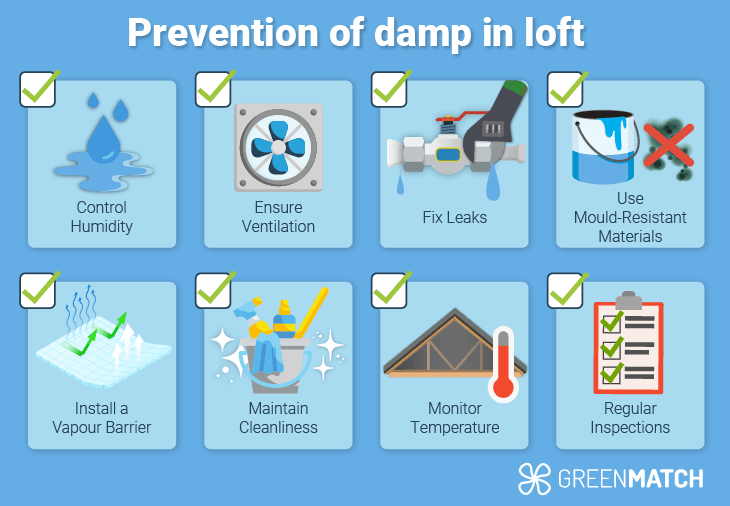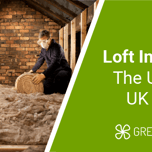Answer these simple questions and we will find you the BEST prices
Which type of solar quotes do you need?
It only takes 30 seconds
100% free with no obligation

Check your eligibility for the Great British Insulation Scheme in minutes

Save up to £440 on your energy bills with proper loft insulation!

The service is 100% free and with no obligation
- GreenMatch
- Insulation
- Loft Insulation
- Condensation in Loft After Insulating
Condensation in Loft After Insulating: Causes, Fixes, and Prevention


- Condensation in lofts is primarily caused by the accumulation of warm, moisture-laden air that becomes trapped due to inadequate ventilation and insulation issues.
- It can be fixed by improving ventilation, optimising insulation, managing moisture, maintaining gutters and checking the loft regularly.
- It can be prevented by maintaining ventilation, managing moisture sources and maintaining a clutter-free loft.
Condensation in loft can become a significant issue with poor insulation jobs, leading to dampness, mould, and structural damage. In this guide, we explore the common causes of condensation in lofts after insulation is installed, offer practical solutions to address the problem and provide tips for preventing moisture buildup in the future, ensuring your loft remains dry and energy-efficient throughout the year.
Addressing condensation in your loft is crucial for maintaining a healthy and safe home environment. Whether you're dealing with existing moisture issues or looking to prevent future problems, taking action now can save you from costly repairs and discomfort down the road.
Are you ready to protect your home? Use our hassle-free service to get in touch with experts and get top-quality insulation products designed to keep your loft dry and efficient all year round. Click the button below to begin!
- Describe your needs
- Get free quotes
- Choose the best offer
It only takes 30 seconds



Can loft insulation cause damp?

Loft insulation or loft insulation between rafters itself does not directly cause dampness, but it can contribute to the problem if not properly installed or if ventilation is inadequate. When loft insulation is added, it can make the loft space cooler by preventing warm air from rising into it.
This cooler environment can lead to condensation when warm, humid air from the house rises and comes into contact with the cooler surfaces in the loft. The condensation can accumulate as water droplets on surfaces like the underside of the roof, potentially leading to dampness and even rot over time.
Improper installation of insulation can exacerbate this issue by blocking ventilation pathways, trapping warm air, and creating cold surfaces that attract moisture. If the insulation is too thick or lacks a proper vapour barrier, it can further contribute to moisture buildup. Therefore, while the insulation itself isn't the cause of dampness, it can create conditions that promote condensation if not managed correctly.
However, a small amount of condensation in the loft during winter is considered normal due to the temperature difference between the warm air inside the home and the cooler surfaces of the loft.
Can damp damage my loft?
If left untreated, dampness can cause significant damage to your loft. The accumulation of moisture can lead to the growth of black mould, decay, and rot, which can compromise the loft's structural integrity.
This damage can affect insulative materials, weaken timber structures, and potentially damage any belongings stored in the loft. Moreover, damp conditions can pose health risks to the inhabitants of the home, including respiratory problems and allergies.
In addition to structural damage, dampness can also result in costly repairs. Moisture can seep into the timber and other building materials, leading to further deterioration if not addressed promptly.
It is crucial to identify the signs of dampness early, such as water marks, musty smells, or visible mould, and take corrective measures to restore the loft to a dry and functional state. At the same time, if only a small part of the loft is affected by dampness, there is a chance that it can dry out by itself.
To ensure the best case scenario, make sure to work with a professional installer when adding loft insulation, and conduct a housing assessment if you are concerned about insulation issues.
How can I remove the damp from my loft?
By taking preemptive steps ahead of time, you can greatly reduce the chances of condensation insulation issues forming in your loft.

Here are some key steps in order to prevent and handle condensation issues for a loft:
- Improve Ventilation: Clear all vents, air bricks, and ventilation systems of obstructions and install additional roof vents if necessary to enhance airflow.
- Use a Dehumidifier: Place a dehumidifier in the loft to reduce moisture levels and help dry out damp areas.
- Check for Leaks: Inspect the roof, gutters, and pipes for any leaks or damage. Repair any leaks to prevent further water ingress.
- Insulate the Loft Hatch: Ensure the loft hatch is well-insulated and sealed to prevent warm, moist air from entering the loft space.
- Remove Affected Materials: Remove any damp or mouldy insulation or materials and replace them as needed.
- Monitor Humidity Levels: Use a hygrometer to monitor humidity levels in the loft and ensure they remain within a healthy range (ideally between 30%-50%).
- Consider Professional Help: If damp persists, consult a professional for a thorough assessment and remediation.
By following these steps, you can effectively remove dampness from your loft and prevent future issues. Use the best loft insulation materials with the help of vetted experts for your home.
Comparing different installers and finding out how much to insulate a loft can take hours of your time. Instead of spending days on research and comparisons on your own, why not fill out our 30-second form and let us do the rest? Through our services, you can receive up to 3 free quotes from trusted installers in your area. Click below to get started!
- Describe your needs
- Get free quotes
- Choose the best offer
It only takes 30 seconds



How can I prevent damp in my loft?
The most effective measures for preventing dampness and condensation in a loft space come from preemtive care. By controlling your home conditions, monitoring your insulation health, and identifying any repair issues, you can keep your loft safe and dry.

Here are some key tips on steps to take:
- Control Humidity: Keep humidity levels below 60% using dehumidifiers or improving ventilation to reduce moisture.
- Ensure Proper Ventilation: Install or maintain vents, fans, or windows to ensure consistent air circulation and prevent moisture buildup.
- Fix Water Leaks: Regularly inspect and repair any roof leaks, plumbing issues, or condensation problems that could introduce moisture into the loft.
- Use Mould-Resistant Materials: Consider using mould-resistant insulation, drywall, or paint in areas prone to moisture.
- Install a Vapour Barrier: Place a vapour barrier on the warm side of the insulation to prevent moisture from entering the loft from below.
- Maintain Cleanliness: Keep the loft clean and free from organic materials like dust or wood that can feed mould growth.
- Monitor and Maintain Temperature: Ensure the loft stays warm enough to avoid condensation but not so warm that it creates a humid environment. Use a dehumidifier if needed.
- Regular Inspections: Periodically check the loft for signs of moisture or mould growth, especially after heavy rain or during seasonal changes.
Should I still insulate my loft?
Yes, you should still insulate your loft, as it provides significant benefits like improved energy efficiency, reduced heating costs, and enhanced comfort. Proper insulation, combined with adequate ventilation and moisture control measures, ensures that you can enjoy the benefits of insulation without the risk of creating problems in your loft space.
By insulating your loft, you can create a more energy-efficient home and lower your heating bills, all while staying comfortable year-round. Another question you might have is loft insulation fireproof? Yes, it is, as long as it is properly maintained.
However, to maximize the benefits of loft insulation and avoid potential moisture or other issues, it’s essential to have your insulation installed by professionals who understand the importance of proper ventilation and moisture control. You can also utilise loft insulation grants to finance your installation. However, finding a reliable installer can take up hours of your time.
Fortunately, you can use Greenmatch’s easy service to connect with trusted loft insulation companies for loft conversion insulation and get the best value for your money. Simply fill out our 30-second form and get up to 3 free and nonbinding quotes! Click the button below to start!
- Describe your needs
- Get free quotes
- Choose the best offer
It only takes 30 seconds



FAQ
Yes, new loft insulation can cause condensation if it is not installed properly. Improper installation, such as placing insulation too close to walls or roofs, can create cold surfaces that draw moisture, leading to dampness.
To stop condensation dripping in your loft, improve ventilation by clearing vents and adding roof vents or extractor fans. Check for and seal leaks from pipes to prevent steam. Using a dehumidifier can help reduce moisture levels and ensure insulation is properly installed without blocking airflow.
Yes, it is normal to have some condensation in the attic during winter. This typically occurs when warm, moist air from the living spaces rises into the colder attic, where it can condense on cold surfaces like the underside of the roof.
Wet loft insulation can dry out if only a small section is damp. However, if large sections are wet or the insulation is thoroughly soaked, it is often better to remove and replace it to prevent mould growth and maintain its insulating properties.
In a loft, a small amount of condensation during colder months can be considered normal due to the temperature difference between the warm air inside the home and the cooler surfaces of the loft.

Anjana has a knack for simplifying complex concepts in an engaging way. She has a background in digital journalism and is committed to delivering impactful content about sustainability and solar energy.
We strive to connect our customers with the right product and supplier. Would you like to be part of GreenMatch?


